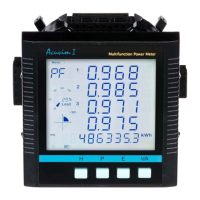205
Series
the results are reported back to the client machine. BACnet defines 5 groups
(or classes) of 35 message types. For example, one class contains messages for
retrieving and manipulating the object properties described above. An example
of a common service request in this class is "ReadProperty." When the server
machine receives this message from a client machine, it locates the requested
property of the requested object and sends the value to the client.
The BACnet protocol consists of Objects that contain different kinds of
information. Each Object has properties that contain data related to it. Below is
the example of an Object for Total Watts:
Object_Name, P_rms
Object_Type, AnalogValue
Object_Instance, 17
Present_Value, watt, tot (value in watts)
For more detailed information, visit the BACnet website at www.bacnet.org.
5.5.4 Using the Acuvim II Series Power Meter’s BACnet
Serial and Ethernet versions
There are a couple of different serial and Ethernet based-versions of BACnet.
The most common serial version is called BACnet MS/TP while the dominant
Ethernet version is BACnet/IP.
BACnet/IP has been developed to allow the BACnet protocol to use TCP/IP
networks. You could say that BACnet/IP is a way of hooking BACnet up to the
Internet and communicate with different Local Area Networks (LANs). This
enables system owners, facility managers, or even external suppliers to access
BACnet networks and manage their devices and systems remotely.

